
Divertimento No. 15
A 'diverting' classic and its contemporary interpreters return to the stage
, May 6, 2021
In his Complete Stories of the Great Ballets, George Balanchine shares an interesting anecdote regarding the creation of Divertimento No. 15, a work which premiered in 1956 at the American Shakespeare Festival Theater in Connecticut:
This ballet is a complete reworking of Caracole, a ballet set to the same music, Mozart’s Divertimento No. 15 in B flat major (K. 287), that was first presented by the New York City Ballet in 1952. Although Caracole had real success when it was first done, we did not dance it for several years and when the dancers and I began to work on a revival in 1956, we found we could remember very little of the original. So many new ballets had intervened that I had to start work all over again! That was not altogether a misfortune, for this score is one I admire most in the world.
This recollection from NYCB’s founding choreographer is of notable interest not merely for what it tells us about his approach to works of the past (Balanchine has often been quoted as saying he “creates works for now”) and his particular fondness for the music of Mozart, but also for its striking contrast with the lasting life of the later work. Nowhere is this persistence more evident than in the Company’s newest dance film, created for its annual Spring Gala. The film celebrates NYCB’s incremental return to its Lincoln Center home, capturing dancers performing excerpts throughout the David H. Koch Theater, concluding with the finale movement of Divertimento, performed onstage for an echoing house of as yet empty seats.
Here is what some of the dancers had to say about recreating this beloved work.
THE BALLET
EMMA VON ENCK: Divertimento No. 15 was one of the first ballets I performed as a corps de ballet member. I remember being a nervous wreck: my legs felt so jittery I feared they would give out any second. After repeatedly performing the ballet, it began to feel second nature to me.
ASHLEY HOD: Balanchine had a way of highlighting the corps in his ballets, and Divertimento is no different. The minuet section for the eight corps ladies is my favorite part to dance, and the principal pas de deux are my favorite to watch—the way each pas de deux flows into the next is so stunning, and it matches the music perfectly. I really grew to appreciate the joyful and community-like atmosphere of the finale during this filming experience.
LAUREN KING: I have danced in Divertimento No. 15 since I was in the corps de ballet. I did the principal pas de deux for a George Balanchine Foundation film with [former NYCB Principal Dancer] Patricia Wilde. [Former NYCB Principal Dancer and current SAB Faculty Chair] Suki Schorer usually teaches these roles, and she worked directly with Balanchine on them; now, as a teacher [at SAB], I get to see her working with the students on them. It's nice to hear all the things that she has to say, in addition to working with the Repertory Directors—to get little things from all different sources. It makes you feel like you have a more complete picture of Balanchine’s intentions. This is one of my favorite types of ballets—very technical, very “ballet.”
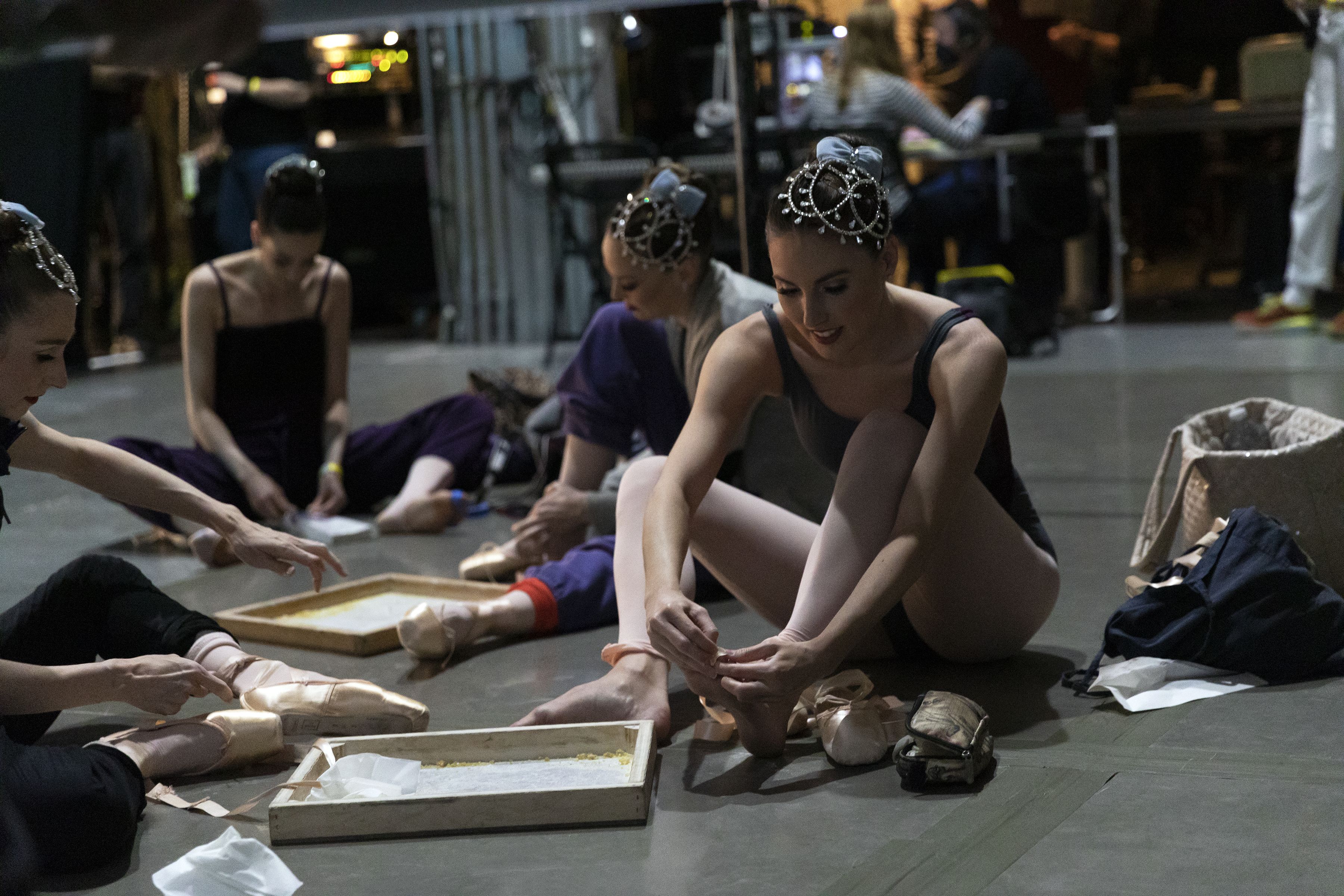
MARY ELIZABETH SELL: I remember watching dancers I admired so much performing the Andante movement on a Balanchine compilation VHS as a little girl, and dreaming about wearing one of those tutus and dancing the choreography. Divertimento also taught me a very important lesson about performing as a young dancer with NYCB. I believe it was my second season dancing the ballet when, during a performance, I went to do a precarious movement, where I am on one toe in arabesque being supported by one of the other women in the corps de ballet, and I lost my center of stability and toppled out of the position. By the next performance I was so nervous and worked up about making that same faux pas that I developed a complex about this one little moment within a great ballet. This insecurity carried on for several more seasons until I finally decided I would not let it get the best of me and take away from the joy of dancing this piece. Now I savor every little movement. I consider this experience to be one of the most valuable lessons of my career thus far.
EMILIE GERRITY: Honestly, I had never performed Divertimento before! I had learned it, but hadn’t gotten a chance to perform it yet. It was a dream. It’s such a great ballet, so musical and fun to dance with friends, especially after having been apart for so long.
OLIVIA MACKINNON: It’s definitely one of those ballets that's very technical. The tutus are very stiff and upright, so your full leg is shown, and there's really no hiding technique at all. It feels very French to me—the costumes, everything, I feel like I'm in a Marie Antoinette-esque world. It's definitely one of my favorite tutus to wear and the colors are beautiful, that French blue and cream and the buttercream yellow. I’ve only performed it once on the David H. Koch Theater stage, so I was so happy to revisit just the finale of the ballet on our stage.
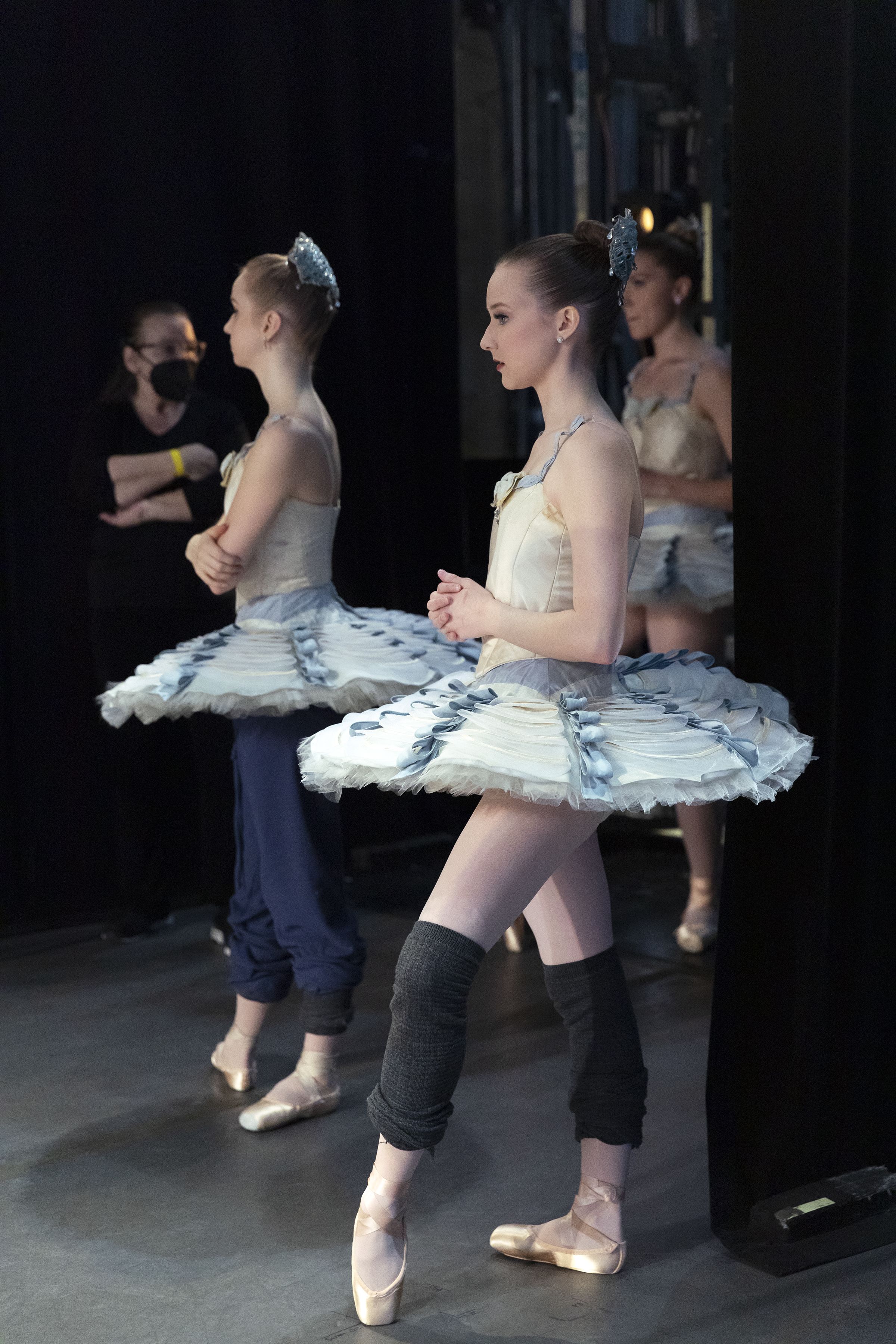
ASHLEY LARACEY: I had always dreamt of doing Divertimento No. 15 and, specifically, the role that I do now. It took me a really long time to get into this ballet. I learned it from Sally [former Principal Dancer and Repertory Director Sara Leland]. The following performance, after I debuted, I had actually broken my foot, so it was my first ballet back—it was a pretty big deal to come back after fracturing my foot. And now it’s the first ballet that I’ve performed for New York City Ballet after having twins. So, for me, this ballet is kind of like a ‘comeback ballet.’ It’s purely classical and really feels like home.
MIRIAM MILLER: Last summer (2020), I was scheduled to perform a variation from Divertimento for the Nantucket Dance Festival. Sadly we could not go to the Island, but the Festival did put together a live stream where I was able to work with [former NYCB Principal Dancer and current SAB Faculty Chair] Suki Schorer virtually on the variation she danced. We worked together through Zoom with the help of [Principal Dancer] Tyler Angle and with [NYCB Piano Soloist] Susan Walters Zooming in on piano from her home. This was a very special re-introduction to the ballet and it came at a time when so much in the world was uncertain. Divertimento was the means by which the four of us could all come together and connect with one another, to remind ourselves of the beauty of ballet.
PREPARATIONS
TILER PECK: I hadn't jumped in a year; I just came back from a neck injury and that's the hardest thing for me. Marika [Molnar, Director of Physical Therapy for NYCB] had said during the year, “Don't jump if you don't have to.” So I kind of went from 0 to 100 and I wasn't quite sure how my body would take it, because there wasn't much lead-up time. The day after, I definitely needed a break—my legs were very tired.
ANDREW VEYETTE: I have been trying to stay as close to performance shape as I possibly could all year. Nothing is quite like having a full workload with New York City Ballet. We work so fast, we work so hard, and we work for such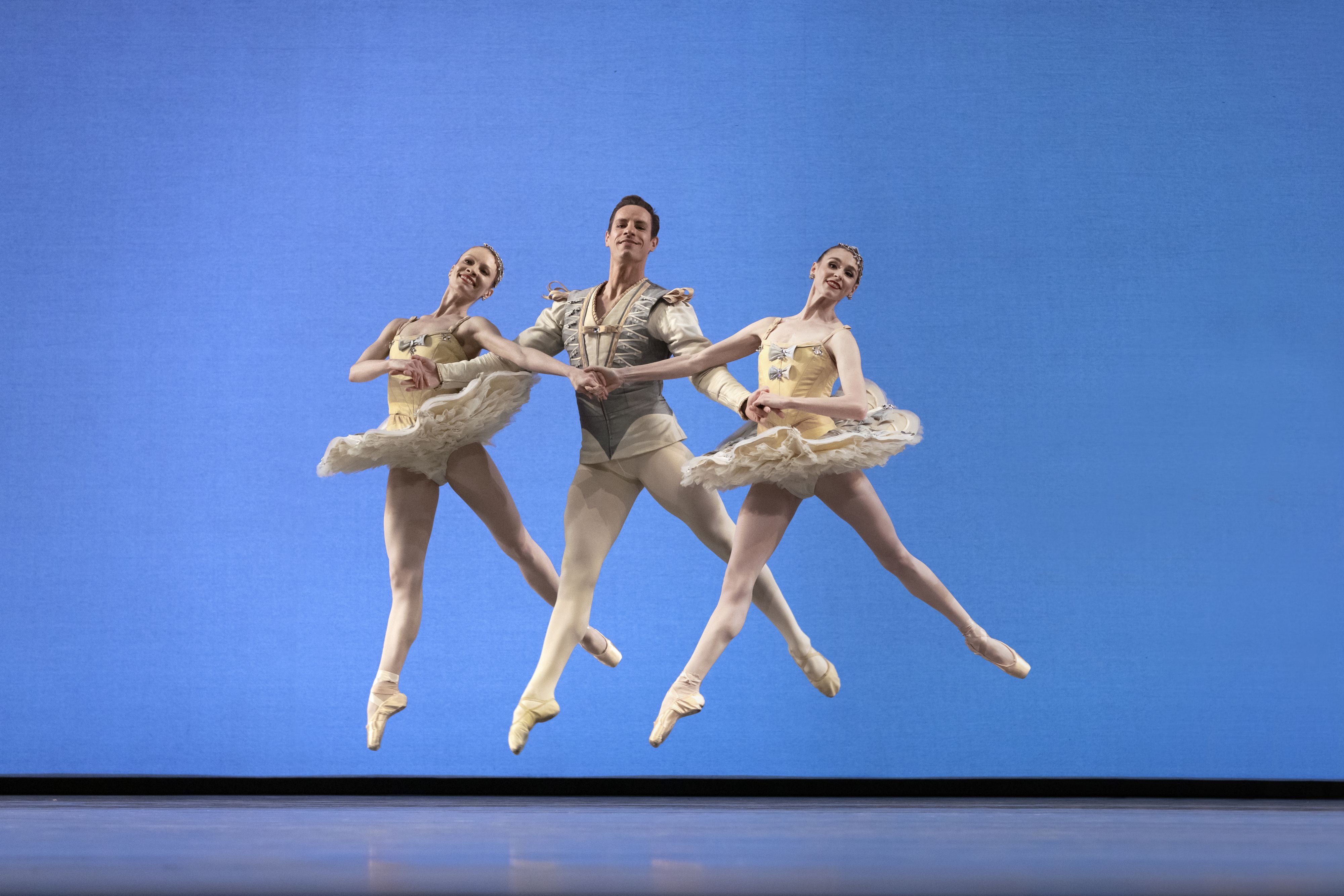
ANDREW SCORDATO: We were reflecting on it together—how with Divertimento, it almost gets easier as you go: the first entrance for the guys is very slow and the jumps are really heavy, then you do this complicated jumping and turning sequence, and it's very exposed, and as soon as that's over, you feel a little better; then you do your solos and then that's over, and you feel a little better; then you have the pas de deux which go by so fast and they're just so fun, you don't really stress about them, and then that's over, all the tension goes away; and then the finale, it's total party mode, because you did all of the harder stuff. So just preparing for the finale felt really strange because it's never that easy, and it will never be that easy again.
KRISTEN SEGIN: In class on the first day, JP [former NYCB Soloist and current Repertory Director Jean-Pierre Frohlich] taught us; he played Serenade music, and I definitely started tearing up a little bit, because just to hear that music onstage brings back all the emotions and how much you miss it.
MARY ELIZABETH SELL: Stepping onto the stage for the first day of class and rehearsal, I didn’t know I would be so overcome with feelings of comfort. The floor felt like an old friend with whom I have a natural flow of conversation, picking up right where we left off. The jewel box I look out into from the stage was just as regal and powerful as ever. Dancing within arm’s reach of my friends gave me a sense of community I hadn’t realized how much I had missed. Ballet is not a solo experience; it’s meant to be shared with other dancers and spectators, even though the audience was a crew of less than ten people and a few repertory directors. I felt like the stage embraced me as much as I embraced it. I felt like I was back where I belong.
ALSTON MACGILL: We rehearsed in person with our repertory directors, got ready in our dressing rooms, and wore our beautiful costumes. Some of these moments were a little surreal the first day, but it also felt like we were picking up right where we’d left off.
FILMING THE BALLET
ANDREW VEYETTE: Performing Divertimento with no audience was an interesting thing to get used to. I think I'm so comfortable after so many years on that stage, that when I perform in front of an audience, I don't feel like I'm really putting on any sort of stage persona. And when we started getting ready to film and perform it with nobody in the house, it was kind of hard to figure out—what makes this performance-level if there's nobody watching it? Luckily there were a handful of people in the audience, colleagues and people that we work with and work for, that we hadn't seen in a really long time, and once I started catching their eyes and smiling at people I hadn't been able to see in a year, then it felt more natural again.
EMILIE GERRITY: I was definitely a little nervous, having not been dancing at the same level that I had been dancing at last March—and then being filmed. [Director Sofia Coppola and cinematographer Philippe Le Sourd] came in and knew what they wanted and were very accommodating when it came to how many times we would have to repeat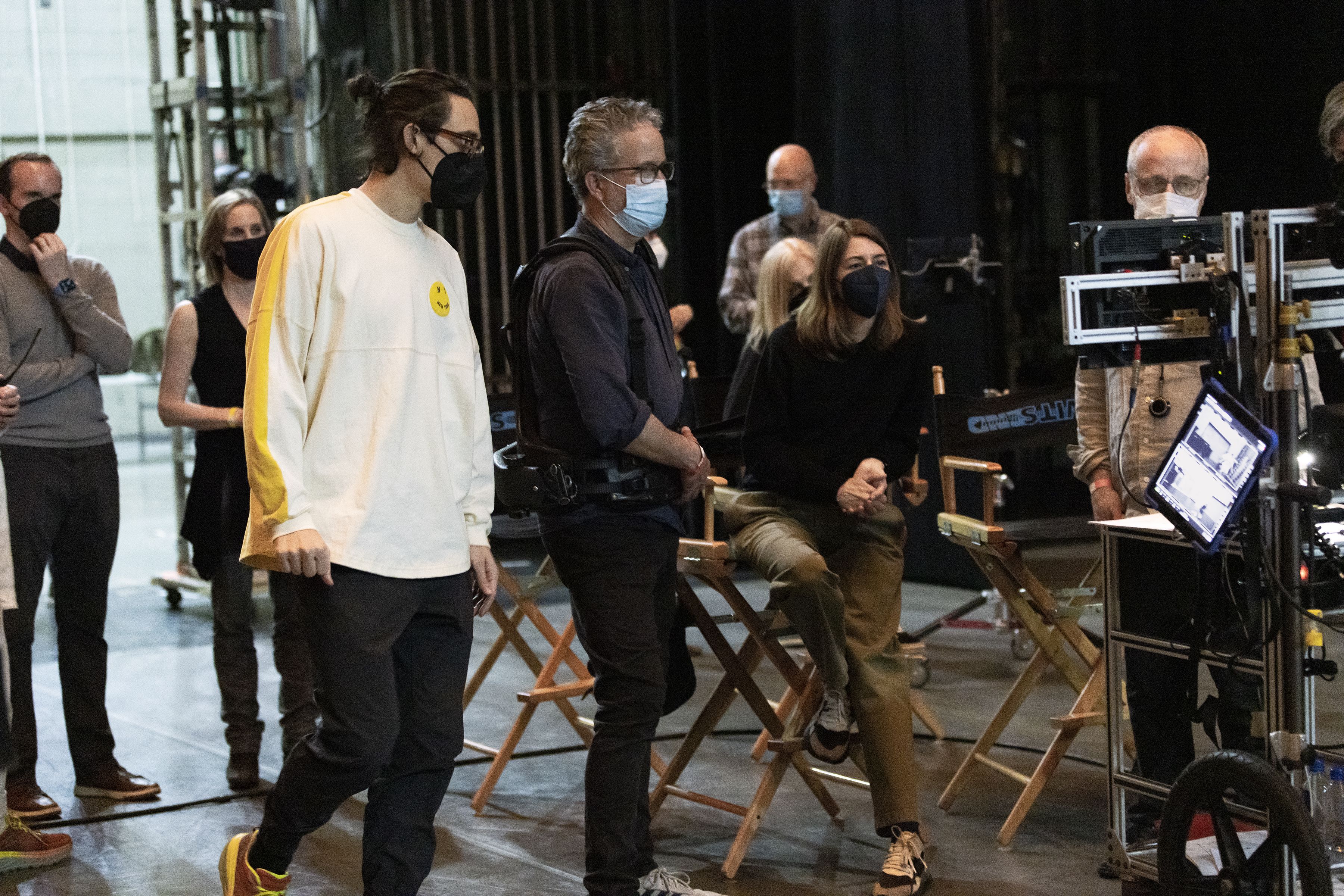
TILER PECK: It was so wonderful to be bringing more of the filmmaking world into the dance and ballet world. I think it'll be nice to see dance from a different viewpoint, coming from a director like [Coppola]—I'm sure it's going to be really interesting to watch how she sees it.
ASHLEY HOD: We did a bunch of takes with them filming from stage level, which I think will bring a really fresh take to Divertimento No. 15. The people watching the film will get to see details and nuances that they might not have been able to see from their seats. Everyone onstage was grinning ear-to-ear from the excitement of being back together, and I know Sofia and Philippe wanted to document as much of that raw emotion as possible.
ISABELLA LAFRENIERE: The admiration and respect they had for the Company was evident. I am fortunate to have had such a once in a lifetime opportunity and am grateful for this memorable experience.
RETURNING TO THE STAGE
ASHLEY LARACEY: It was amazing to be back in the Theater. I've been gone since June 2019. I had the season of my life—I debuted in Symphony in Three Movements, Stravinsky Violin Concerto, and Scotch Symphony, all in a very short amount of time. My last show was June 3rd, dancing Hermia in A Midsummer Night’s Dream, which I've done for years, and I was 14 weeks pregnant with the twins. So leaving the stage knowing that I was going to have kids, I was expecting to come back for [our 2020 Kennedy Center tour in Washington,] D.C.; then that was taken away, and it just seemed like it'd been an eternity since I'd been [in our Theater]. So it definitely felt amazing just to be back and in my second home.
EMMA VON ENCK: Divertimento has moments of quick sequences and grand port de bras artfully synced to Mozart's musical score. After such a long separation from performing, revisiting the ballet felt like a reunion. Even without a live audience, being back in the theater dancing together was invigorating.
LAUREN KING: It felt really interesting to be in costume again. I haven’t worn anything but the same clothes, and they’re pajamas or work-out clothes. So to be in a sparkly, beautifully-designed tutu felt like it always feels—like “I can't believe I get to wear this.” We don't really do anything these days that is presentational, or even if it is, you have an extra layer of a mask that's not meant to be attractive. So to put on a costume that is such a visual representation of what the ballet is, I really enjoyed that, and it felt like all the elements came together.
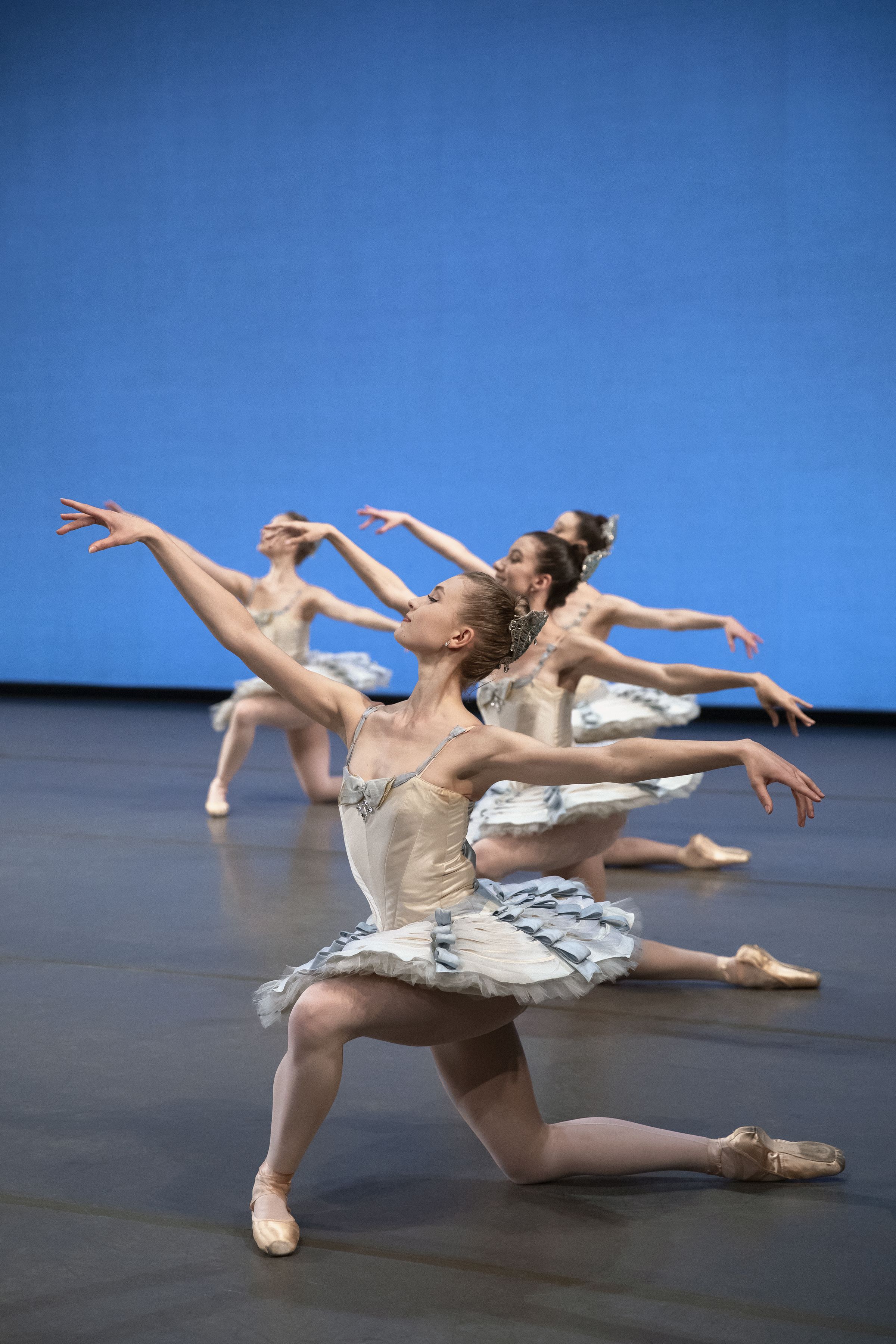
MIRIAM MILLER: Any ballet would have been special to perform, but Divertimento, in particular, is one of those classic Balanchine ballets that highlights the true brilliance of his work. From day one of rehearsal, I was immediately reminded of Balanchine’s immense musicality and speed, as well as how much my body loves dancing his choreography. I felt like a ballet dancer again for the first time in months, which was also inspired by the stunning tutus and headpieces.
ANDREW VEYETTE: I never thought that during my time in this Company I was going to see something like this—a whole year of not being around, not performing at the theater. It's almost devastating, except that it's given me a great appreciation for how fortunate we are to get to do such a beautiful thing in such a beautiful place.
ANDREW SCORDATO: It was so nice to be back and in so many ways it felt like we never left, so I hope that when everyone is back in person, and our audiences [are back], that we can all just jump back into enjoying this, when it’s safe—which I know it will be one day. Hopefully it'll feel like no time has gone by, even though it's been a really tough year in so many ways. I hope that we can just dive in headfirst, like we were never gone.
According to legendary dance critic Edwin Denby, dancers have been particularly fond of Divertimento since its debut; he notes that it took the ballet a decade to achieve popularity, and did so due to the efforts of the dancers themselves. To return again to Balanchine’s words in the Great Stories, for a pithy summary of the work’s inspiration:
Mozart wrote the Divertimento when he was twenty-one. He composed many similar works, pieces designed for special social occasions, large garden parties, carnivals, balls. All of these pieces were written to divert and charm audiences that expected to be entertained. Very often people danced to them. This particular divertimento is probably the finest ever written.
With his typical insouciance, Balanchine describes the effect of both the score and, in many ways, his own ballet. But as the recollections and reflections of the dancers above demonstrate, a ballet doesn’t require any greater goal than to “divert” to be a triumph, and to win a permanent place in the performers’—and audience members’—hearts.



